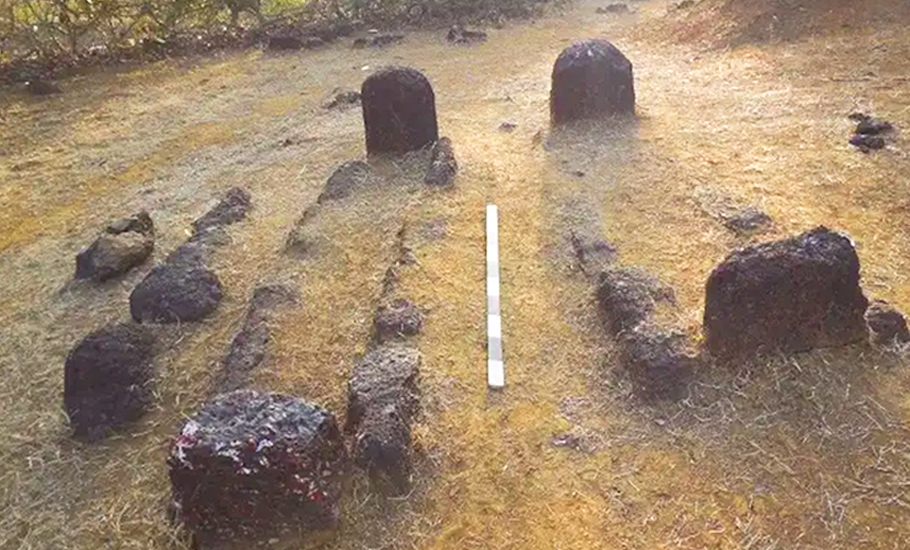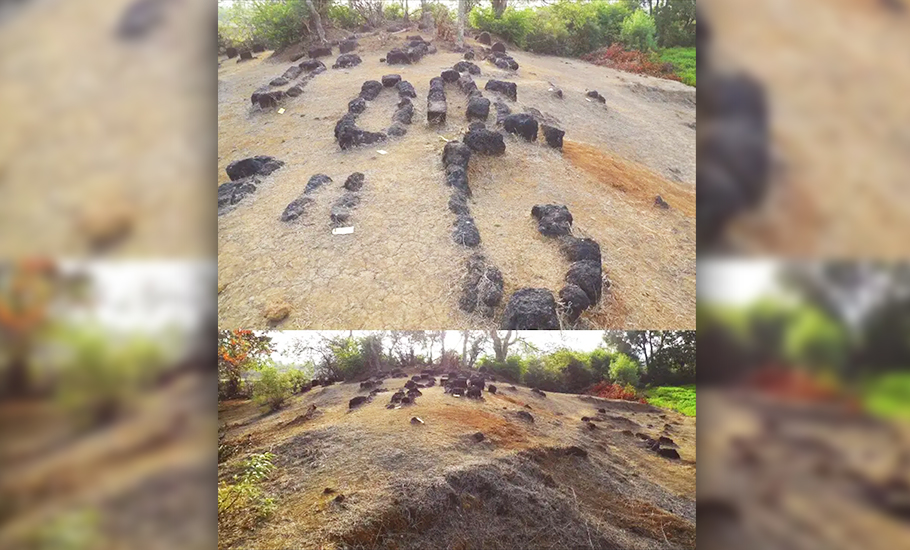
- Home
- News
- Analysis
- States
- Perspective
- Videos
- Education
- Entertainment
- Elections
- World Cup 2023
- Features
- Health
- Business
- Series
- Economy Series
- Earth Day
- Kashmir’s Frozen Turbulence
- India@75
- The legend of Ramjanmabhoomi
- Liberalisation@30
- How to tame a dragon
- Celebrating biodiversity
- Farm Matters
- 50 days of solitude
- Bringing Migrants Home
- Budget 2020
- Jharkhand Votes
- The Federal Investigates
- The Federal Impact
- Vanishing Sand
- Gandhi @ 150
- Andhra Today
- Field report
- Operation Gulmarg
- Pandemic @1 Mn in India
- The Federal Year-End
- The Zero Year
- Premium
- Science
- Brand studio
- Home
- NewsNews
- Analysis
- StatesStates
- PerspectivePerspective
- VideosVideos
- Entertainment
- ElectionsElections
- Sports
- Loading...
Sports - Features
- BusinessBusiness
- Premium
- Loading...
Premium

Of Chandore, Bene Israel and public archaeology

When a team of archaeologists decided to explore Chandore, a remote, nondescript village in the Raigad district of Maharashtra, little did they know that the off-the-beaten track would throw up surprises one after the other. In 2011, a team led by archaeologist Kurush F Dalal, discovered the mediaeval temple site called Chandore. The site yielded a number of plinths, a man-made tank, and a...
When a team of archaeologists decided to explore Chandore, a remote, nondescript village in the Raigad district of Maharashtra, little did they know that the off-the-beaten track would throw up surprises one after the other.
In 2011, a team led by archaeologist Kurush F Dalal, discovered the mediaeval temple site called Chandore. The site yielded a number of plinths, a man-made tank, and a number of sculptural members of the Northern Shilahara (752–1265 AD) style, and later periods. In 2015, the team found a Bene Israel graveyard during the excavations at Chandore. The Bene Israel, according to Kurush F Dalal, are the largest and oldest of several groups of Jews found in India. The Marathi-speaking Bene Israelis lived in the villages and towns of the Konkan coast for hundreds of years.
According to their own oral traditions they are the descendants of seven men and seven women who survived a shipwreck on the Konkan coast more than 2,000 years ago.
Haim Samuel Kehimkar, author of The History of the Bene Israel of India, posits that they are descendants of Judaean refugees who made for Cheul after the ascent to the throne of Hellenistic Seleucid king Antiochus IV Epiphanes, who reversed an earlier policy of tolerance. Kehimkar claims the date of their arrival goes as far back as 175 BCE, while other sources consider a later arrival around the 6th century CE, from Arabia or Persia.
“They were slowly absorbed into the contemporary Konkani society whilst maintaining a few rudimentary Jewish observances. There were more than 30,000 Bene Israelis in Maharashtra in the 1950s. Today, there are less than 5,000, as most have migrated to Israel. They adopted Hindu names, the Marathi language and local dresses. They took up oil pressing as their profession, retained the Sabbath holiday traditions, circumcision and the recitation of the Shema (Jewish prayer),” said Kurush, according to whom the Chandore cemetery with over 70 graves belonging to a single family that had left the village before 1955, makes the last possible burial at least 60 years ago.
It was after a series of joint archaeological excavations conducted by the Centre of Archaeology, Centre for Extra-Mural Studies, University of Mumbai and the India Study Centre (INSTUCEN) Trust, Mumbai that the significance of Chandore came to light. In the course of the investigations, the team has found an amazing wealth of data and established a continuous occupation at Chandore from the early medieval Shilahara/Yadava period (12th Century AD) to modern times. The team found bangles, coins, ceramics, sculptural remains, memorial stones, land-grant stones, temple complexes, rock-cut tanks and two man-made lakes on the premises. The team also located 23 new contemporary sites in the region and it came across a large number of burials on a small mound in Chandore. “The 70 burials then appear to be much more than just another 100 years of occupation and we are looking perhaps at the oldest hitherto surviving Bene Israel cemetery in Raigad,” he said, while speaking on ‘The excavations at Chandore: An exercise in public archaeology’ at an online talk organised by the Bihar Heritage Development Society recently.
The team mapped a total of 70 complete and partial burials. “There are 41 complete burials of which 32 are seemingly intact. The rest of the burials are either disturbed or have been robbed partially of their stone blocks. The burials consist of roughly dressed laterite blocks interspersed in a very few cases with one or two basalt blocks. The blocks making up the burials are of various shapes and sizes. In many cases only one line of stones is visible. The basic shape of the burials is rectangular and almost all the burials are incredibly narrow.” he said.

As the members in the team recorded the details of the graves one by one carefully, they noticed an east-west orientation in them. The researchers first thought that these were Islamic graves in an Islamic cemetery. But that was not true as the Islamic burials in India are in general oriented north-south, with the faces of the dead turned west towards Mecca. The team of archaeologists then spoke to the villagers of Chandore, who said there were no Muslims living in the village and there had never been any as per oral traditions.
However, a second round of conversation with some senior citizens in the village of Chandore, according to Kurush F Dalal, led to an exciting revelation. “The mound is locally known as the ‘Telinchya Mashmoda’, (the burial ground of the Telis). The Telis are essentially a community of oil pressers. In the Raigad region, the community that was traditionally ensconced in this profession was known as the ‘Shaniwar Telis’ (the Saturday oil pressers). They were known thus as they professed the Jewish faith and observed Shabbat by not working on Saturdays. These Shaniwar Telis have been the focus of much debate. They are also known as the Bene Israel (Hebrew for sons of Israel),” said Kurush.
The first synagogue of the Bene Israelis was built in Mumbai in 1796. “Bene Israelis played an important role in colonial India. After the creation of the state of Israel in 1948, many of them began to migrate to Israel under the promise of ‘the return’ or, large-scale migrations that took place after the Israeli Rabbinate declared them ‘full Jews in every respect’ in 1964. Today, there are very few Bene Israelis left in Raigad and most definitely none in the villages immediately around Chandore,” he added.
The main oil seed in this region was kala til (black sesame) and was grown as a secondary crop by all local farmers. “As and when required it was pressed fresh and brought home for use. Thus, the disappearance of the Bene Israel from these regions has had a very great impact on the consumption patterns of oil in the coastal areas of Raigad. Little or no oil is now pressed locally, or oil crops grown. People have shifted to packaged oil transported from the hinterland,” wrote Kurush in the research paper titled The Discovery of a Bene Israeli Cemetery During the Archaeological Investigations at Chandore, which he co-authored with scholar Raamesh Gowri Raghavan.
The oil press was usually running all day long as villagers came with their own oil seeds as and when requirements arose in their houses. The press was animal powered and used a bullock to carry out the pressing.
Kurush said discussions with professor Shalva Weil of Hebrew University in Israel led the team to the interesting fact that as far as her knowledge goes there is no evidence for any Bene Israel cemeteries that are over 100 to 150 years old in the Raigad district. “The Chandore cemetery with over 70 graves belonging to a single family which we know had left the village before 1955 makes the last possible burial at least 60 years ago. The 70 burials then appear to be much more than just another 100 years of occupation and we are looking perhaps at the oldest hitherto surviving Bene Israel cemetery in Raigad. This, of course, is an incredibly rich opportunity to carry out demographic studies on a clan endogamous group,” said Kurush, director of INSTUCEN School of Archaeology, Mumbai.
The Centre for Extra Mural Studies (CEMS), University of Mumbai has been carrying out excavations in the early medieval site of Chandore with the help of the India Study Centre (INSTUCEN) Trust, Mumbai since 2011. The joint explorations in Chandore revealed two temple complexes and a scatter of memorial stones, sculptural members and a large rock-cut tank. “Excavations revealed to our surprise a wealth of sculptural, structural, numismatic and ceramic data that could be used as temporal markers for the early medieval period and late medieval periods. It clearly established the purpose of the site as an important trade node between the coast and the hinterland and revealed a wealth of information on local temple architecture and a hitherto new form of sculptural marker – the Gay-Vasaru Pillar,” said Kurush. The Gay-Vasaru Pillar is a new type of sculptural element/stele that has been primarily found and identified at Chandore.
“It is a Shilahara era marker and will help in further identifying such sites in the region,” he added.
Chandore is an example of how archaeological explorations can be conducted with the support of the local people. “No records about Chandore were available. The only academically published mention of Chandore is a small three-line stub in the old Gazetteer (Kolaba Gazetteer 1964) of the Kolaba (now Raigad) District. So, we used to speak to the villagers in Chandore. They helped us a lot. We organised meetings with elders in the village. Our continuous interaction with the villagers in Chandore helped us a lot in the exploration. It is called public archaeology,” said Kurush.

